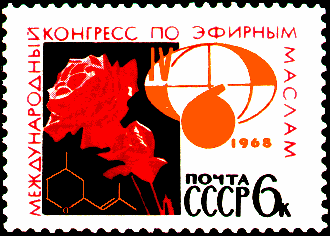Aroma from Carotenoids - Rose (original) (raw)
Rose (Rosa damascena)
A Review by John C. Leffingwell, Ph.D.
This a part of our series on aroma materials produced by carotenoid degradation.

From the time of the Romans (and probably before) the aroma of the rose was valued for its fragrant perfume.
Chemists have known for over 100 years that the main constituent of Rose oil is citronellol, but it wasn't until work in the 1960's & 70's that the trace constituents so essential to a rose fragrance were reported. Of the more than 275 constituents of Bulgarian rose oil, Ohloff reviewed the aroma contribution of both major and minor components [Perfumer & Flavorist, 3, 1, 11-22 (1978); Ohloff, G.; Scent and Fragrances, The fascination of odors and their chemical perspectives; translated by W. Pickenhagen and B. Lawrence, Springer-Verlag, Pub., Berlin - Heidelberg;, 1994, pp. 154-158. ]. Utilizing the Odor unit concept of Guadagni, Buttery & Harris [J. Sci. Food. Agric., 17, 142-144 (1966)] in which an "Odor unit" value is assigned based on dividing the concentration of a component (in ppb) by the components detection threshold level ( in ppb), Ohloff calculated the relative odor contribution for both major and minor components:

| Component | % of Oil | Threshold in ppb | Odor Units x 10-3 | Rel. % of odor units |
|---|---|---|---|---|
| (-)-Citronellol | 38 | 40 | 9500 | 4.3 |
| C14 - C16 Paraffins | 16 | - | - | - |
| Geraniol | 14 | 75 | 1860 | 0.8 |
| Nerol | 7 | 300 | 233 | 0.1 |
| Phenethyl alcohol | 2.8 | 750 | 37 | 0.016 |
| Eugenol methyl ether | 2.4 | 820 | 29 | 0.013 |
| Eugenol | 1.2 | 30 | 400 | 0.18 |
| Farnesol | 1.2 | 20 | 600 | 0.27 |
| Linalool | 1.4 | 6 | 2300 | 1.0 |
| (-)-Rose oxide | 0.46 | 0.5 | 9200 | 4.1 |
| (-)-Carvone | 0.41 | 50 | 82 | 0.036 |
| Rose furan | 0.16 | 200 | 8 | 0.003 |
| beta-Damascenone | 0.14 | 0.009 | 156000 | 70.0 |
| beta-Ionone | 0.03 | 0.007 | 42860 | 19.2 |
As should be noted, the minor constituents beta-damascenone and beta-ionone provide a significant majority of the odor contribution.
This research by Firmenich led to the discovery of the so-called Rose Ketones, beta-Damascenone and beta-Damascone (also a trace constituent), two of the most important fragrance & flavor chemicals of this century; both of which (along with beta-ionone), are derived from carotenoid degradation.
.
The importance of the rose ketones has allowed the creation of dramatically new type perfumes [as exemplified by by Diors "Poison" (1985)], wherein damascenone and the alpha- & beta-damascones may be used at quite high levels.
Although not a carotenoid degradation product, the terpenoid ether (Rose oxide) was another significant discovery from Firmenich that contributes to rose aroma. A discovery that warranted a USSR postage stamp.
Rose Oxide
Story of the Rose from Shiseido
Back to The Carotenoids Page...... Home.......Back to In the News
Other Subjects on the Leffingwell & Associates Site
Telephone: 01-770-8895111 - Email:leffingwell@mindspring.com
Copyright © Leffingwell & Associates
TERMS OF SERVICE.............PRIVACY POLICY

